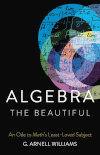- About MAA
- Membership
- MAA Publications
- Periodicals
- Blogs
- MAA Book Series
- MAA Press (an imprint of the AMS)
- MAA Notes
- MAA Reviews
- Mathematical Communication
- Information for Libraries
- Author Resources
- Advertise with MAA
- Meetings
- Competitions
- Programs
- Communities
- MAA Sections
- SIGMAA
- MAA Connect
- Students
- MAA Awards
- Awards Booklets
- Writing Awards
- Teaching Awards
- Service Awards
- Research Awards
- Lecture Awards
- Putnam Competition Individual and Team Winners
- D. E. Shaw Group AMC 8 Awards & Certificates
- Maryam Mirzakhani AMC 10 A Awards & Certificates
- Two Sigma AMC 10 B Awards & Certificates
- Jane Street AMC 12 A Awards & Certificates
- Akamai AMC 12 B Awards & Certificates
- High School Teachers
- News
You are here
Algebra the Beautiful

Publisher:
Basic Books
Publication Date:
2022
Number of Pages:
416
Format:
Hardcover
Price:
32.00
ISBN:
978-1541600683
Category:
General
[Reviewed by , on ]
Tom French
04/16/2023
We have all seen the coffee mug, card, or sign which reads “Well, another day has passed and I didn’t use algebra even once!” Such thoughts and attitudes are often expressed by many of those who found algebra to be perplexing and baffling while studying the subject in school. Author G. Arnell Williams demystifies algebra in Algebra the Beautiful.
The book shows that algebra is not an isolated subject. Rather, the study of algebra and all mathematics is an integral part of many aspects of our daily lives. In fact, we all use algebra several times each day, oftentimes without even realizing it. Author Williams provides numerous examples throughout the text to demonstrate this to the reader.
The book’s opening chapter begins by demonstrating that sometimes arithmetic is not enough. The language of arithmetic allows us to determine a solution for just one particular problem. Whereas, the language of algebra allows us to determine and express a multitude of solutions, not just for one single problem but for a whole class of similar problems. An example of solving a multitude of problems rather than just a single problem is exemplified by a problem that requires an individual to enter such parameters as 1) how many times a week you like to eat out; 2) how many years have passed since 2013; and 3) in which year you were born. This is a singular problem, but the inputs vary from person to person and in what year the person solves the problem. This and similar problems are presented early in the book and are referenced in subsequent chapters as the author and reader develop additional and more complex algebraic concepts.
This book is not an algebra textbook. Although it develops elementary algebra in much the same manner as classical algebra textbooks would, that is, it introduces variables to replace specific numbers, it goes on to develop algebraic expressions, simplifying expressions, and eventually solving both linear and quadratic equations. Numerous examples of traditional algebra problems along with applied problems encountered in all our lives keeps the text pragmatic.
Algebra the Beautiful includes a gentle history of the invention of algebra. The reader is treated to a light review of Diophantine equations, the work of Al-Khwarizmi, Viète, Pythagoras, de Fermat, and host of other contributors to the development of algebra. The reader is also treated to enlightening historical discussions of the pros and cons of introducing the subject of algebra into both high schools and universities in the United States. These historical accounts are perceptive and thorough.
The author presents several examples of how “algebraic thinking” throughout history has had a profound impact on how we understand our universe. The book’s presentations on the observations of French physicist Antoine Henri Becquerel and his deductions of exponential decay as well as the development and impact of spectroscopy by Gustav Kirchhoff are both superb. As a result of their algebraic thinking, we understand radioactivity and are able to determine the elemental components of light coming to the Earth from millions and millions of miles away.
I recommend this book for teachers and professors of algebra and pre-algebra. Author Williams provides plenty of ‘food-for-thought’ for those teachers who wish to teach algebra as more than just a series of algorithms to memorize and aspire to help students learn an algebraic way of thinking.
Tom French has a B.S. and a M.S. degree in Mathematics from Minnesota State University, Mankato. He has 35 years of engineering and business experience with UNIVAC and its successor companies. He has lectured on mathematics and computer systems throughout the world and has taught mathematics at a number of US colleges and universities.
See the publisher's website.
- Log in to post comments




